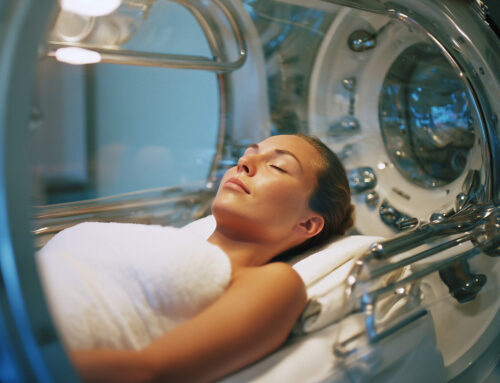Autism Spectrum Disorder (ASD) affects 1 in 36 children in the US, with challenges in social communication, behavior, and sensory processing (Maenner et al., 2023). While traditional therapies are the cornerstone of autism treatment, Hyperbaric Oxygen Therapy (HBOT) is a complementary therapy that is showing promise in addressing some of the underlying physiological issues of autism.
What is Hyperbaric Oxygen Therapy
Hyperbaric Oxygen Therapy involves breathing pure oxygen in a pressurized chamber, typically at 1.3 to 3.0 times normal air pressure. This increased pressure allows the lungs to take in much more oxygen than breathing pure oxygen at normal air pressure, resulting in higher oxygen levels in blood plasma and tissues (Jain, 2017).
Originally developed to treat decompression sickness in divers, HBOT is used to treat various medical conditions, including wound healing, carbon monoxide poisoning, and certain infections. The therapy increases oxygen delivery to tissues, promotes cellular repair, reduces inflammation, and supports the body’s natural healing processes.
The Biological Rationale for HBOT in Autism
Research has found several physiological abnormalities in autistic children that can be addressed with increased oxygen delivery. Many children with ASD have mitochondrial dysfunction, which affects cellular energy production and can impact brain function (Rossignol & Frye, 2012). Mitochondria need oxygen to produce ATP, the cell’s primary energy currency, and increased oxygen availability through HBOT may help optimize mitochondrial function.
Also, studies have shown chronic inflammation and oxidative stress in many individuals with autism (Bjørklund et al., 2020). The anti-inflammatory properties of HBOT and its ability to increase antioxidant enzyme activity may help address the underlying biological processes contributing to autism symptoms.
Cerebral hypoperfusion or reduced blood flow to specific brain regions has been found in some children with autism (Ito et al., 2005). HBOT can increase cerebral blood flow and oxygen delivery to brain tissues and may support better neurological function.
Clinical Evidence and Research Findings
Several clinical studies have been done on HBOT in children with autism, with varying but generally positive results. A randomized, double-masked, controlled trial by Rossignol et al. (2009) found that children receiving HBOT at 1.3 atmospheres with 24% oxygen showed significant improvements in overall functioning, receptive language, social interaction, and eye contact compared to those receiving slightly pressurized air.
A larger study by Granpeesheh et al. (2010) with 62 children with autism showed improved social skills, cognitive function, and sensory/cognitive awareness after HBOT treatment. The children received 40 sessions of HBOT at 1.3 atmospheres with 24% oxygen over 4 weeks.
Long-term follow-up studies have shown that improvements may be sustained over time. Rossignol et al. (2012) found that benefits observed immediately after HBOT treatment were maintained at 3-month and 6-month follow-up assessments, indicating that the therapy may produce lasting changes rather than temporary improvements.
However, not all studies have shown significant benefits. A Cochrane review by Bennett et al. (2015) concluded that while some studies showed promise, the overall evidence for HBOT in autism is limited, and future high-quality research is required.
6 Significant Benefits in Children with Autism
Parents and clinicians have reported various improvements in children with autism after HBOT treatment. These include:
- Communication and Language: Many children show enhanced verbal communication, increased vocabulary, and better understanding of spoken language. Some non-verbal children start using words or phrases after HBOT treatment (Rossignol et al., 2009).
- Social Interaction: Improvements in eye contact, social awareness, and engagement with family members and peers occur daily. Children show increased interest in social activities and better understand social cues.
- Behavioral Changes: Reductions in repetitive behaviors, self-stimulatory activities, and aggressive behaviors are everyday observations. Children may show improved attention span and focus during activities.
- Sensory Processing: Many children experience improvements in sensory sensitivities and can tolerate various textures, sounds, and environmental stimuli that previously caused distress.
- Cognitive Function: Enhanced learning ability, improved memory, and better problem-solving skills are reported benefits of increased brain oxygenation and cellular function.
- Sleep and Appetite: Improvements in sleep patterns and appetite regulation are common and can cascade positive effects on behavior and development.
HBOT protocols for autism typically involve mild hyperbaric pressure (1.3 atmospheres) with 24-100% oxygen concentrations. Treatment sessions are 60-90 minutes and are done daily or several times weekly. A typical treatment course is 40-80 sessions, but protocols vary based on individual needs and response.
The therapy is generally well-tolerated by children and has minimal side effects when properly administered. Mild side effects may include ear pressure or discomfort during pressure changes, temporary fatigue, or, rarely, temporary vision changes. Proper ear equalization techniques and gradual pressure changes help minimize discomfort.
Safety protocols are essential as oxygen under pressure can be hazardous if not properly managed. Treatment should only be done in certified facilities with trained personnel and appropriate safety equipment.
Integration with Comprehensive Treatment
HBOT should be seen as a complementary therapy, not a standalone treatment for autism. The most effective approach combines HBOT with established interventions like Applied Behavior Analysis (ABA), speech therapy, occupational therapy, and appropriate educational programming.
The timing of HBOT with other therapies may be important. Some practitioners suggest that HBOT may enhance the effectiveness of different interventions by improving neurological functions essential for learning and development.
Current Limitations and Future Research
While promising HBOT for autism has several limitations, the cost can be high as insurance does not cover treatments for autism applications. Access to certified HBOT facilities may be limited in some areas.
Research limitations include small sample sizes in most studies, variations in treatment protocols, and the challenge of blinding in clinical trials due to the nature of pressurized environments.
Future research directions include identifying biomarkers to determine which children will benefit from HBOT, optimizing treatment protocols, and conducting large-scale, long-term studies to establish efficacy and safety profiles.
Conclusion
Future advancements in Hyperbaric Oxygen Therapy for autism may include:
- Personalized Protocols: Developing individualized HBOT protocols based on each child’s genetic markers, biomarkers, and specific physiological abnormalities. This precision medicine approach could optimize treatment outcomes.
- Technological Enhancements: Innovations in HBOT chamber technology, such as more comfortable and child-friendly designs, enhanced monitoring systems, and integration with virtual reality or sensory tools to improve the treatment experience.
- Combination Therapies: Research into synergistic effects of HBOT when combined with other emerging therapies, such as stem cell therapy, nutritional interventions, or targeted pharmacological treatments.
- Telemedicine and Remote Monitoring: Expanding access to HBOT through remote consultation, monitoring, and potentially home-based mild hyperbaric chambers under medical supervision for certain cases.
- Advanced Research Methodologies: Utilizing advanced neuroimaging techniques (e.g., fMRI, PET scans) and genetic sequencing to better understand the mechanisms of action of HBOT in the autistic brain and identify objective measures of improvement.
While more research is needed to establish HBOT’s role in autism carefully, the existing evidence suggests it may be a valuable addition to comprehensive treatment programs for some children. Parents considering HBOT should work with qualified healthcare providers to determine if this therapy suits their child’s needs and circumstances.
4 Key Takeaways of HBOT Research and Autism in Kids
1. Several clinical studies have investigated the effects of HBOT on children with autism, with varying but generally positive results. A randomized, double-masked, controlled trial by Rossignol et al. (2009) found that children receiving HBOT at 1.3 atmospheres with 24% oxygen significantly improved overall functioning, receptive language, social interaction, and eye contact compared to those receiving slightly pressurized air.
2. A larger study by Granpeesheh et al. (2010) involving 62 children with autism demonstrated improvements in social skills, cognitive function, and sensory/cognitive awareness following HBOT treatment. The children received 40 sessions of HBOT at 1.3 atmospheres with 24% oxygen over four weeks.
3. Long-term follow-up studies have suggested that improvements may be sustained over time. Rossignol et al. (2012) reported that benefits observed immediately after HBOT treatment were maintained at 3-month and 6-month follow-up assessments, indicating that the therapy may produce lasting changes rather than temporary improvements.
4. However, it is important to note that not all studies have shown significant benefits. A Cochrane review by Bennett et al. (2015) concluded that while some studies showed promise, the overall evidence for HBOT in autism remains limited, and more high-quality research is needed.
If you have any questions please contact our Hyperbaric Oxygen Clinic in Brooklyn, NY located at 1659 Ralph Ave. Our phone number is 718-255-9955






